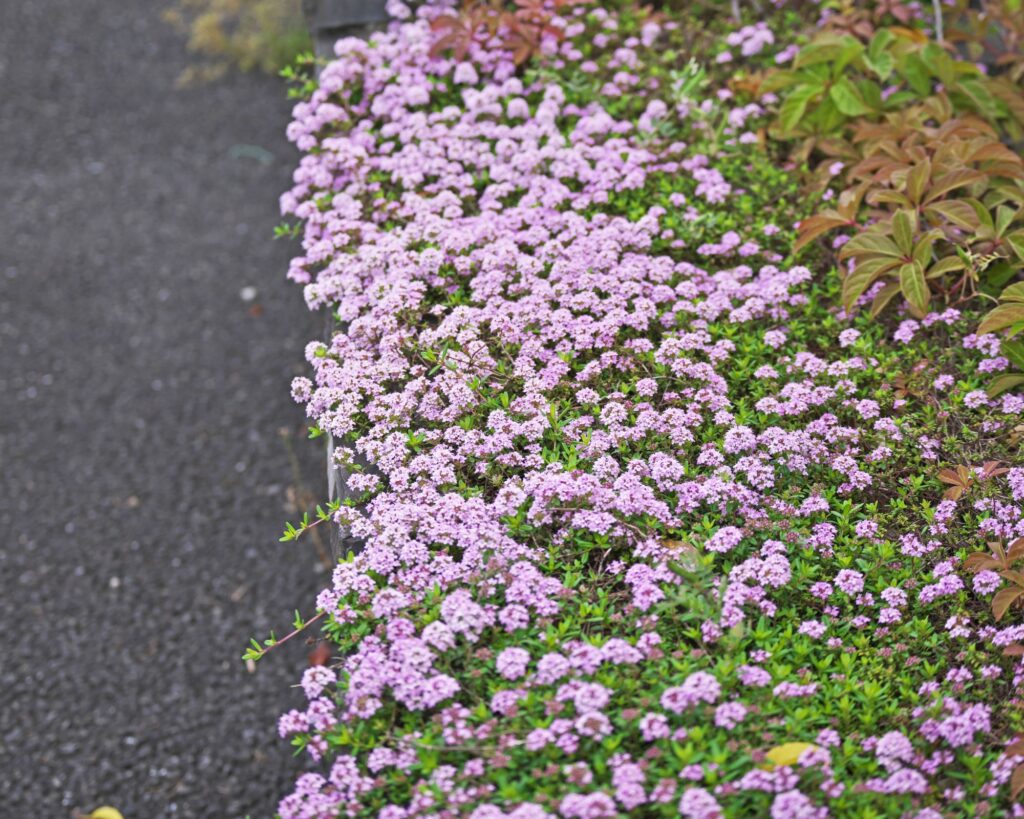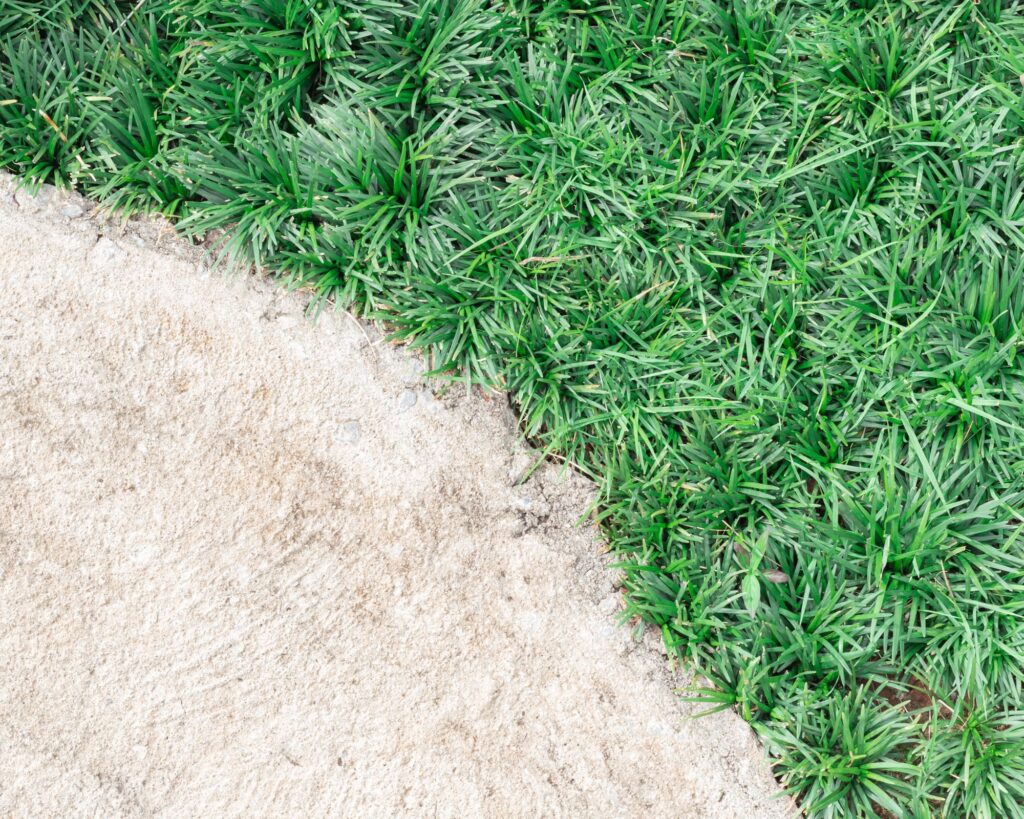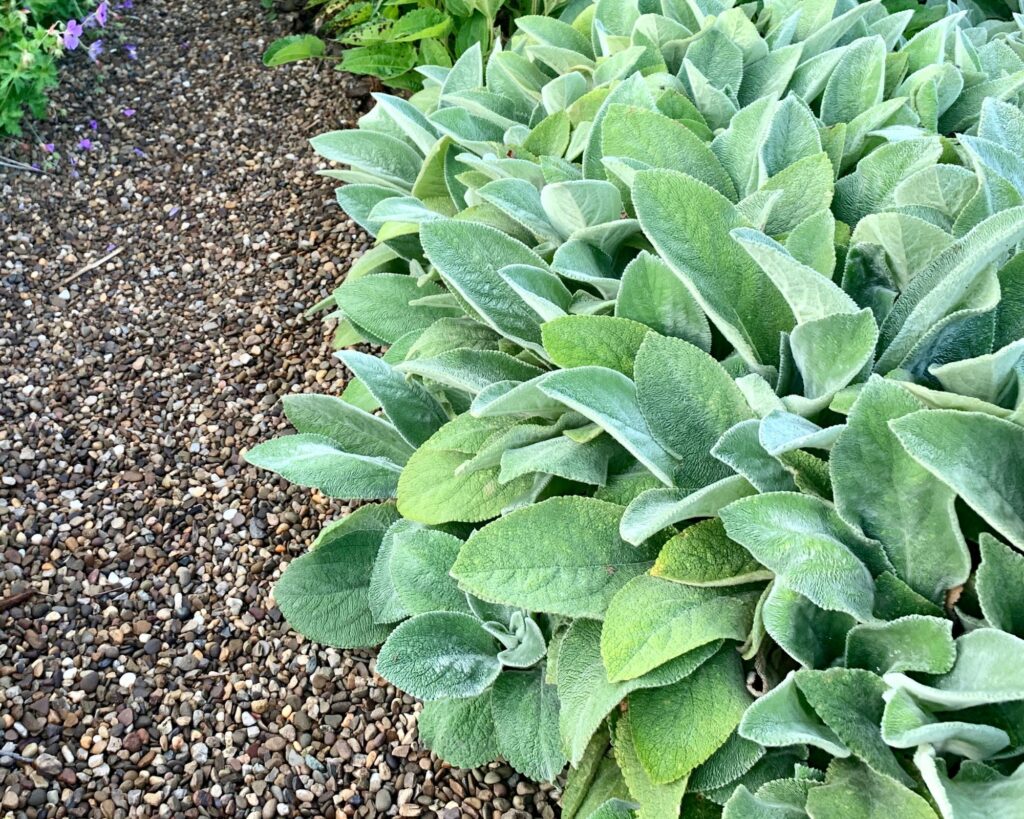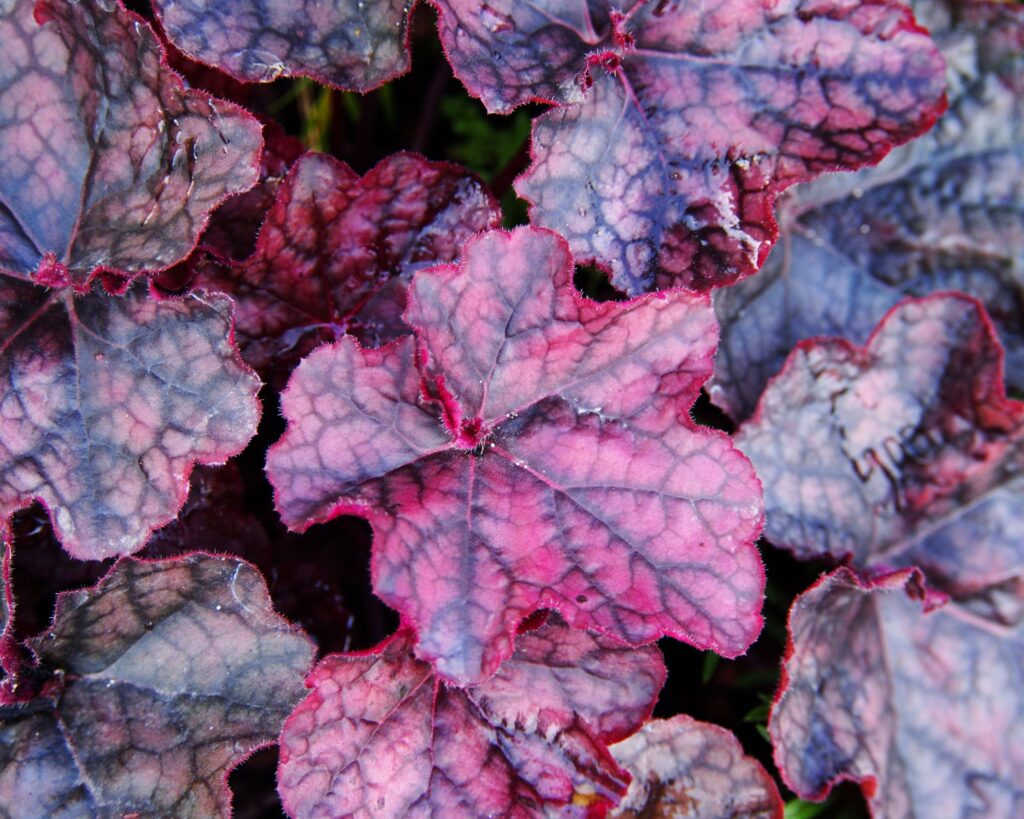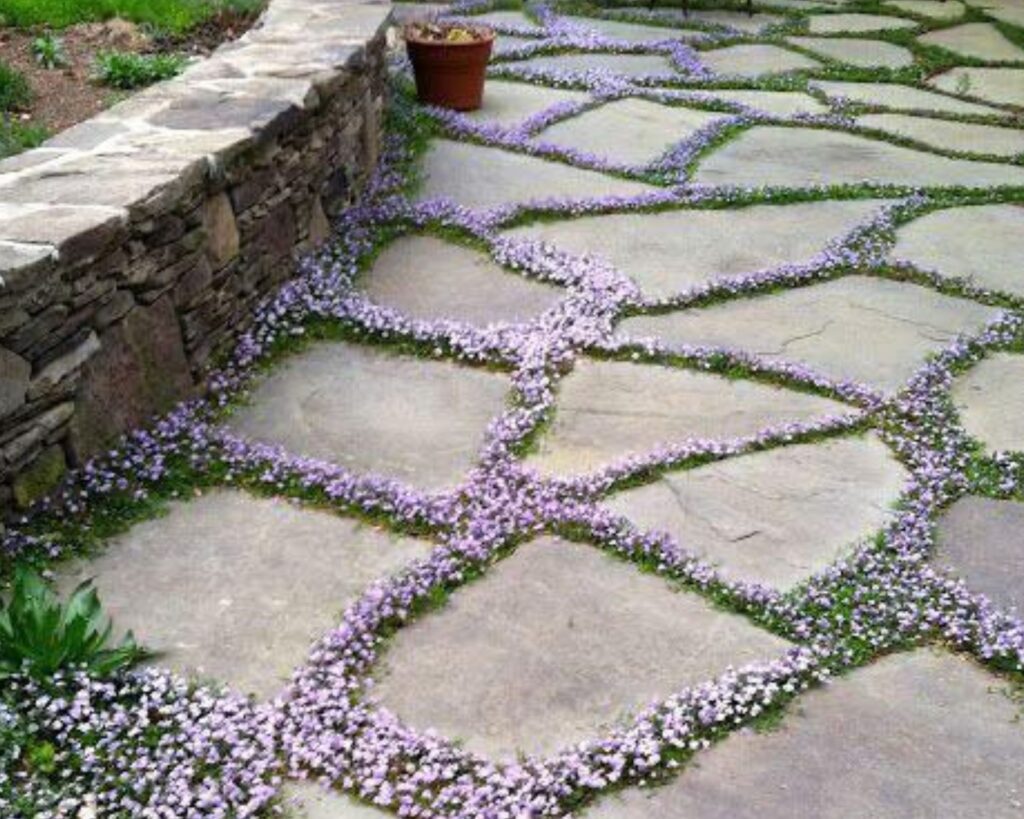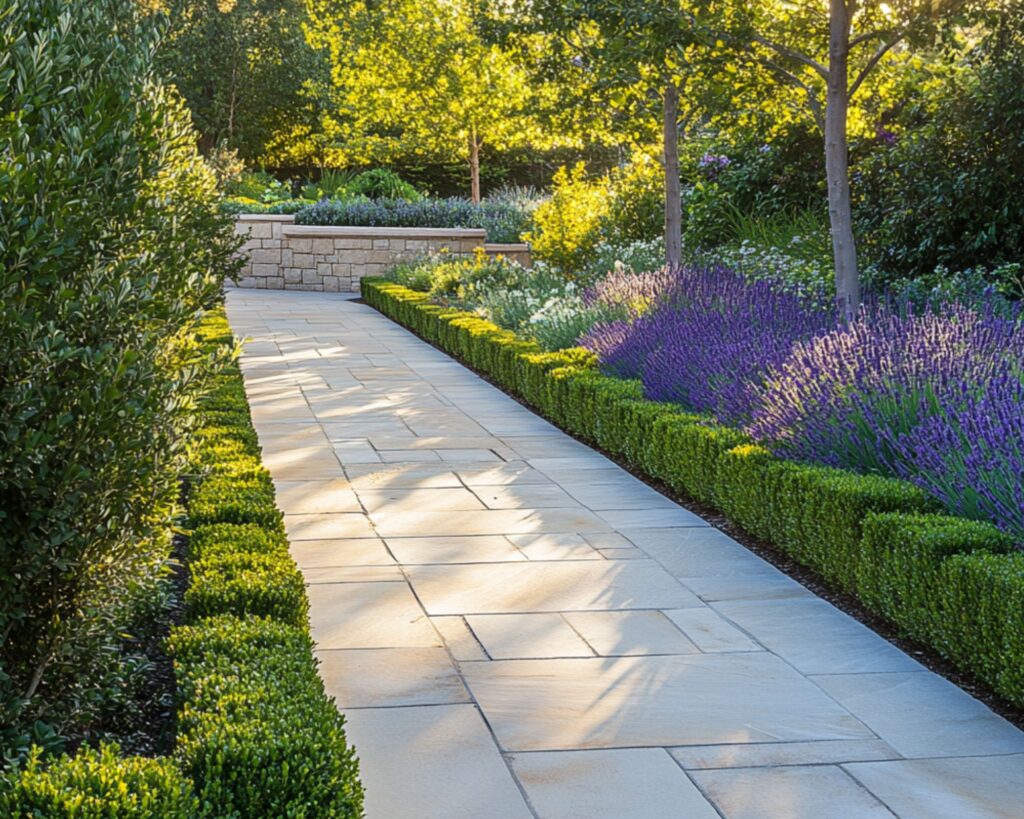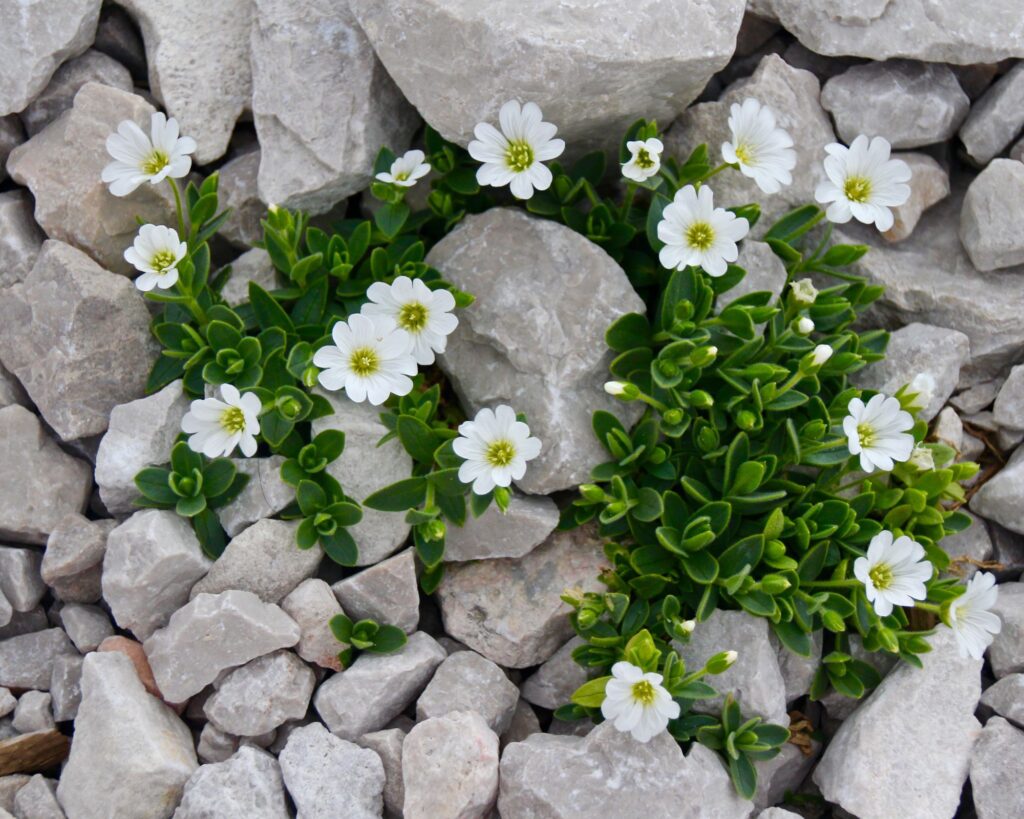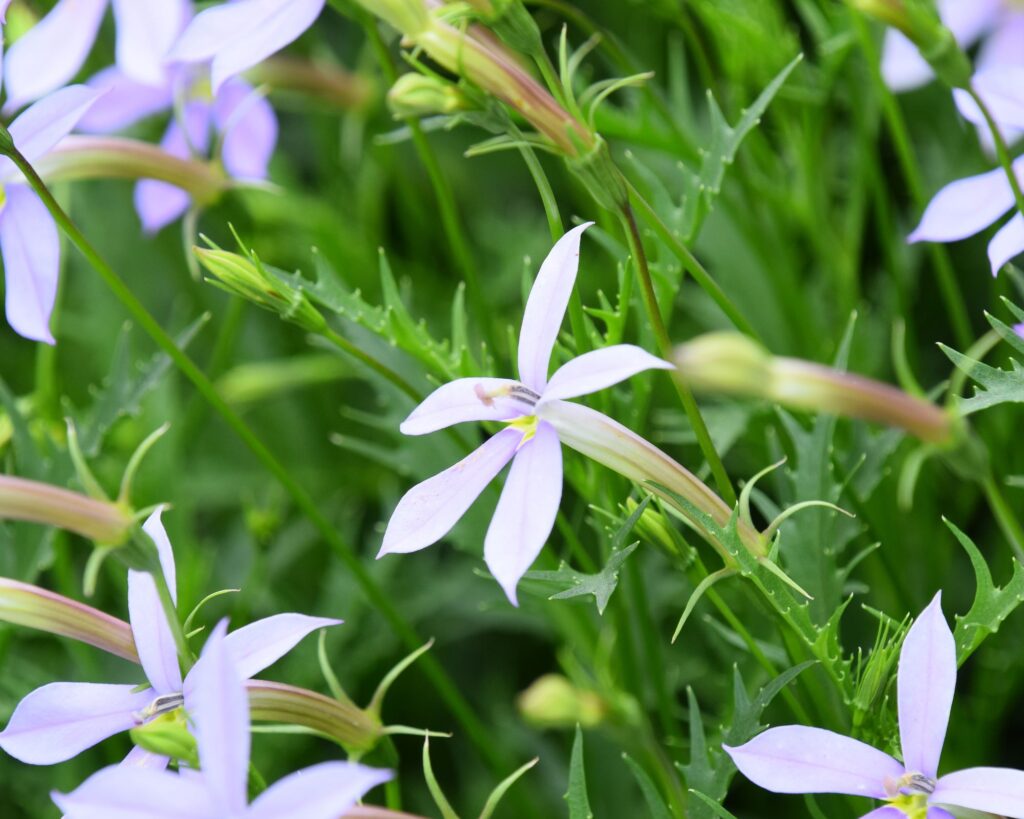Have you ever thought of your garden walkway as more than just a functional path? It can be so much more – a vibrant, lush pathway that draws you in with color, texture, and fragrance at every step.
The right plants can elevate your walkway from ordinary to extraordinary. Whether you’re envisioning a sleek, polished garden path or a casual, nature-inspired trail, these 15 plants will guide you in transforming your walkway into a charming, inviting space.
Ready to find out which plants can work magic on your garden path?
1. Creeping Thyme (Thymus serpyllum)
Creeping thyme is one of the best choices for walkway edges because it offers both beauty and functionality. Its tiny, aromatic leaves form a dense, ground-hugging mat, while small purple or pink flowers bloom in summer.
What makes creeping thyme particularly ideal is its resilience – it can withstand light foot traffic, and the delightful fragrance released when stepped on is an added bonus.
- Why it’s perfect: It’s drought-tolerant, low-maintenance, and releases a fresh, herbal fragrance when walked upon.
2. Dwarf Mondo Grass (Ophiopogon japonicus ‘Nana’)
For a more structured, modern look, dwarf mondo grass is a fantastic choice. This evergreen ground cover has a neat, clumping habit with rich green, grass-like foliage.
It’s slow-growing and stays under 4 inches tall, making it a good border for a clean, sleek walkway.
- Why it’s perfect: Its low height and minimalist appearance add structure to formal walkways, and it’s tolerant of shady areas.
3. Sedum (Sedum spp.)
Sedums, also known as stonecrop, are perfect for sunny walkways where drought-tolerance is key. These succulents come in a wide variety of colors and textures, from soft, fleshy leaves to star-shaped flowers.
They thrive in poor soil and need very little water, making them ideal for hot, dry climates.
- Why it’s perfect: Their low-maintenance nature and ability to survive in harsh conditions make sedums a smart choice for sunny paths.
4. Lamb’s Ear (Stachys byzantina)
Known for its soft, velvety leaves, lamb’s ear is a favorite for walkways, especially in cottage-style gardens. Its silver-gray foliage creates a beautiful contrast against green plants, and it can handle full sun to partial shade.
Lamb’s ear grows in low, spreading clumps, making it perfect for softening the edges of a walkway.
- Why it’s perfect: The fuzzy, silver leaves add texture and are soft to the touch, making it a tactile delight along walkways.
5. Corsican Mint (Mentha requienii)
Corsican mint is a charming, low-growing herb that forms a lush mat of tiny, fragrant leaves. This plant is excellent for filling in between stepping stones or along the sides of walkways, where it can thrive in moist, well-drained soil.
Like thyme, it releases a pleasant aroma when stepped on.
- Why it’s perfect: It’s a fragrant, soft ground cover that can take some foot traffic and adds a sensory element to your garden.
6. Heuchera (Heuchera spp.)
Commonly known as coral bells, heuchera offers not only pretty flowers but also striking foliage that comes in a variety of colors, including deep purple, lime green, and burgundy.
It thrives in partial shade and is perfect for adding color and texture along a shaded walkway.
- Why it’s perfect: Heuchera’s colorful foliage brings year-round interest and creates a stunning visual contrast when used along shaded walkways.
7. Irish Moss (Sagina subulata)
Irish moss creates a soft, velvety green carpet that looks fantastic along walkways or between stepping stones. It stays low, only growing to about 2 inches tall, and provides a lush, bright green accent.
Irish moss is perfect for cooler climates and moist, well-drained soil.
- Why it’s perfect: Its mossy appearance is ideal for creating a naturalistic look, especially in cooler climates with consistent moisture.
8. Hosta (Hosta spp.)
If your walkway is shaded, hostas are a great choice. Their large, leafy foliage creates a striking presence, and they come in a wide range of colors and sizes.
From small varieties perfect for edging to large ones that create bold statement borders, hostas are versatile and easy to grow.
- Why it’s perfect: Hostas thrive in the shade and provide bold, textured leaves to enhance the edges of walkways.
9. Ajuga (Ajuga reptans)
Ajuga, also known as bugleweed, is a fast-spreading ground cover with attractive, low-growing foliage and spikes of blue or purple flowers. It’s an excellent option for shady walkways, where it will quickly fill in spaces and suppress weeds.
Ajuga comes in different varieties with variegated leaves that add even more visual interest.
- Why it’s perfect: Its quick growth and colorful foliage provide excellent ground coverage for shaded paths, creating a lush, weed-resistant barrier.
10. Sweet Alyssum (Lobularia maritima)
Sweet alyssum is a low-growing annual that adds a delicate touch to walkways. With tiny clusters of white, pink, or purple flowers, it creates a carpet of blooms that are not only visually appealing but also attract pollinators like bees and butterflies.
Sweet alyssum works well along the edges of garden paths or between pavers.
- Why it’s perfect: It’s a pollinator-friendly plant with a sweet fragrance and soft, spreading habit, ideal for walkways.
11. Mazus (Mazus reptans)
Mazus is a low-growing ground cover that’s perfect for walkways with its small, bright green leaves and delicate purple or white flowers.
It spreads quickly and can tolerate light foot traffic, making it ideal for filling gaps between stepping stones or softening the edges of paths.
- Why it’s perfect: Mazus is resilient, handles foot traffic, and brings a charming, whimsical look to walkways.
12. Dianthus (Dianthus spp.)
Dianthus, also known as pinks, is a wonderful edging plant with its compact, mounding habit and pretty, fringed flowers. The blooms are usually in shades of pink, red, or white and emit a sweet, spicy fragrance.
Dianthus does best in sunny spots and well-drained soil.
- Why it’s perfect: Its compact size and fragrant flowers make dianthus a lovely, classic choice for walkway edges.
13. Lavender (Lavandula spp.)
Lavender is a fantastic option for walkways, offering both beauty and fragrance. Its gray-green foliage and tall spikes of purple flowers create a beautiful contrast along garden paths.
As you walk by, the unmistakable scent of lavender fills the air, creating a calming, sensory experience.
- Why it’s perfect: Lavender’s scent and drought-tolerance make it an ideal plant for sunny, dry walkway edges.
14. Snow-in-Summer (Cerastium tomentosum)
Snow-in-summer is a fast-spreading, silver-leaved ground cover that produces a profusion of white flowers in early summer. It’s perfect for sunny walkways where it can spread and create a bright, reflective border.
Its silvery foliage contrasts beautifully with green plants, adding light and texture to your path.
- Why it’s perfect: Its silvery foliage and bright white flowers bring a fresh, cool look to sunny walkways.
15. Blue Star Creeper (Isotoma fluviatilis)
Blue star creeper is a low-growing ground cover with tiny blue flowers that bloom from spring through summer. It spreads quickly, forming a dense mat that works well in between stepping stones or along walkway edges.
Blue star creeper is tough, can handle some foot traffic, and is perfect for creating a soft, floral carpet underfoot.
- Why it’s perfect: Its delicate blue flowers and resilience make blue star creeper a beautiful, functional ground cover for pathways.
The perfect plants for walkways can transform the look and feel of your garden. Whether you’re looking for soft ground covers like creeping thyme, or bolder, flowering options like lavender, there’s a plant for every type of path.
With a little planning, you can create a stunning walkway that not only leads you through your garden but enhances the entire experience.
These 15 plants will help you define the edges of your walkways while adding beauty, fragrance, and texture to your landscape.

